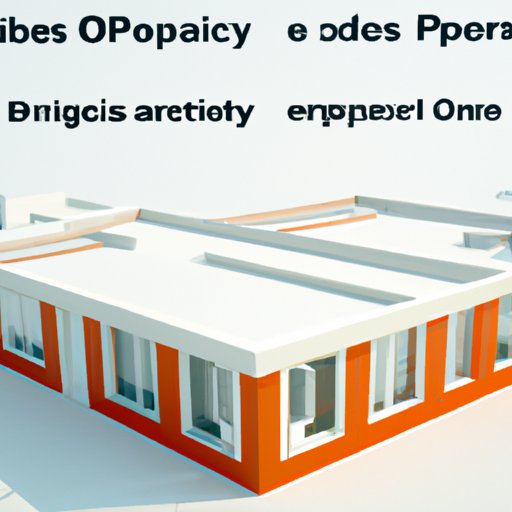Introduction
Open architecture is a type of computing system that provides users with flexibility in terms of how they use their hardware and software. It allows them to build custom solutions that are tailored to their business needs. This type of architecture has been around since the 1970s and has become increasingly popular as businesses look for ways to increase efficiency and reduce costs. In this article, we’ll explore what open architecture is, its benefits and its applications.

Exploring the Benefits of Open Architecture
Open architecture provides businesses with several advantages. These include increased flexibility and scalability, lower cost of ownership, and improved security.
Increased Flexibility and Scalability
One of the main benefits of open architecture is increased flexibility and scalability. This means that businesses can easily add or remove components to their systems without having to replace existing hardware or software. This makes it easier to customize solutions for specific needs, as well as allowing for rapid changes if necessary.
Lower Cost of Ownership
Open architecture also helps businesses save money on ownership costs. Because they don’t have to purchase additional hardware or software, they can keep their overall costs down. Additionally, because the architecture is open, businesses can use the same hardware and software across multiple locations, which further reduces costs.
Increased Security
Open architecture also provides improved security. Because the architecture is open, users can more easily customize their systems to meet their security needs. This can help protect sensitive data from external threats and ensure that the system remains secure.

Understanding Open Architecture and its Applications
Open architecture can be applied in a variety of ways, depending on the specific needs of the business. There are several different types of open architectures, including client/server, distributed, and service-oriented. Each of these architectures has its own advantages and disadvantages and can be used for different purposes.
Types of Open Architecture
Client/server architecture is one of the most common types of open architecture. It involves the use of multiple computers connected over a network. The server acts as the central hub for all of the client computers, which are then able to access the resources available on the server. This type of architecture is often used for web hosting and other applications that require multiple computers to access the same resources.
Distributed architecture is another type of open architecture. This involves the use of multiple computers that are connected to each other but not necessarily to a central server. This type of architecture is commonly used for distributed computing applications, such as grid computing and cloud computing.
Service-oriented architecture (SOA) is a type of architecture that uses services as the primary building blocks of the system. Services are small pieces of code that can be used to access and manipulate data stored on a server. SOA is often used for web services, such as those that allow websites to interact with databases.
Examples of Open Architecture Applications
Open architecture can be used for a variety of applications, including web hosting, e-commerce, enterprise resource planning (ERP), customer relationship management (CRM), and workflow automation. Each of these applications requires different types of open architecture in order to function properly.
For example, web hosting typically requires a client/server architecture in order to provide access to websites across multiple computers. E-commerce applications often use distributed architecture in order to spread out the workload across multiple computers. ERP and CRM applications usually involve the use of service-oriented architecture in order to allow different systems to communicate with one another.
The Advantages of Open Architecture for Businesses
Open architecture provides businesses with several advantages, including improved efficiency, increased productivity, and increased collaboration. By using open architecture, businesses can create custom solutions that are tailored to their specific needs and can benefit from the flexibility and scalability that the architecture provides.
Improved Efficiency
Open architecture can improve the efficiency of businesses by reducing the amount of time and effort needed to configure and maintain systems. This is because open architecture allows businesses to quickly add or remove components as needed, without having to replace existing hardware or software. Additionally, open architecture can reduce the need for manual configuration, as many components can be configured automatically.
Increased Productivity
Open architecture can also increase the productivity of businesses by providing access to resources across multiple computers. This allows businesses to access the same resources from any location, which can help speed up processes and reduce the amount of time needed to complete tasks.
Increased Collaboration
Open architecture can also help businesses collaborate more effectively by providing access to shared resources. This allows businesses to share information and collaborate on projects from any location, which can help improve communication and increase the effectiveness of teams.
An Overview of Open Architecture Technology
Open architecture technology is the foundation for open architecture applications. It provides the tools and frameworks needed to create and manage open architecture systems. This technology includes components such as operating systems, web servers, databases, and application programming interfaces (APIs).
Components of Open Architecture
The components of open architecture technology include operating systems, web servers, databases, and APIs. Operating systems provide the basic infrastructure for running applications, while web servers provide access to websites and other Internet-based services. Databases store and manage data, while APIs allow different systems to communicate with one another.
Benefits of Open Architecture Technology
Open architecture technology provides several benefits for businesses. It can help businesses reduce costs by eliminating the need for additional hardware or software. Additionally, it can improve efficiency and productivity by providing access to resources across multiple computers. Finally, it can help improve collaboration and communication by allowing businesses to share information and work together on projects from any location.

How Open Architecture Can Improve Network Performance
Open architecture can also improve network performance by increasing reliability, speed, and data transfer. By using open architecture, businesses can optimize their networks for better performance. This can help reduce latency, improve response times, and increase the number of connections that can be made at once.
Improved Network Reliability
Open architecture can help improve the reliability of networks by making it easier to configure and maintain systems. This can reduce the risk of downtime, as well as helping to ensure that the network is always functioning optimally.
Increased Network Speed
Open architecture can also increase the speed of networks by allowing businesses to optimize their systems for faster performance. This can help improve response times and reduce latency, allowing for smoother and faster data transfers.
Enhanced Data Transfer
Finally, open architecture can enhance data transfer by allowing businesses to make multiple connections at once. This can help increase the speed of data transfers and reduce the amount of time needed to complete tasks.
Comparing Closed and Open Architectures
It’s important to understand the differences between closed and open architectures in order to determine which type is best for a particular application. Both types of architectures have their advantages and disadvantages, so it’s important to consider the specific needs of the business before making a decision.
Common Characteristics
Both closed and open architectures have some common characteristics. Both types of architectures involve the use of multiple computers connected over a network. Additionally, both types of architectures can be used for web hosting and other applications that require multiple computers to access the same resources.
Differences Between Closed and Open Architectures
The key difference between closed and open architectures is that open architectures are designed to provide users with more flexibility. This means that users can customize their systems to meet their specific needs, as well as being able to add or remove components as needed. Closed architectures, on the other hand, are more rigid and require users to purchase additional hardware or software in order to make changes.

Examining the Pros and Cons of Open Architecture
Open architecture has several advantages, such as increased flexibility, scalability, and cost savings. However, there are also some potential drawbacks to consider. These include the potential for security vulnerabilities, lack of vendor support, and difficulty in troubleshooting complex systems.
Pros
The main advantages of open architecture include increased flexibility, scalability, and cost savings. Open architecture allows businesses to customize their systems to meet their specific needs, as well as being able to add or remove components as needed. Additionally, open architecture can help businesses save money on ownership costs, as they don’t have to purchase additional hardware or software.
Cons
The potential drawbacks of open architecture include security vulnerabilities, lack of vendor support, and difficulty in troubleshooting complex systems. Open architecture can make systems more vulnerable to external threats, as users can more easily customize their systems to meet their security needs. Additionally, open architecture can be difficult to troubleshoot due to the complexity of the systems involved.
Conclusion
Open architecture is an increasingly popular type of computing system that provides users with increased flexibility and scalability. It can be used for a variety of applications, including web hosting, e-commerce, ERP, CRM, and workflow automation. Open architecture provides businesses with several advantages, including improved efficiency, increased productivity, and increased collaboration. Additionally, open architecture can help improve network performance by increasing reliability, speed, and data transfer. Although open architecture has several advantages, there are also some potential drawbacks to consider, such as security vulnerabilities and difficulty in troubleshooting complex systems.
(Note: Is this article not meeting your expectations? Do you have knowledge or insights to share? Unlock new opportunities and expand your reach by joining our authors team. Click Registration to join us and share your expertise with our readers.)
